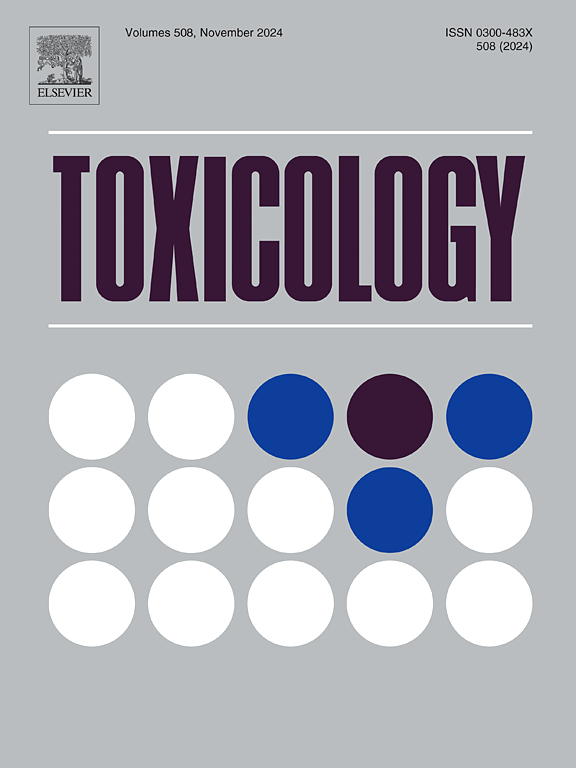两种有机磷化合物:一种农药和一种沙林结构类似物对小鼠亚致死中毒引起的呼吸毒性的表征和比较。
IF 4.6
3区 医学
Q1 PHARMACOLOGY & PHARMACY
引用次数: 0
摘要
最近的国际事件(如叙利亚冲突、诺维乔克中毒事件)和紧张的地缘政治气候突出表明,与使用有机磷神经毒剂有关的化学品风险仍然是一个重大关切。与此同时,有机磷农药的使用仍然是全球公共卫生面临的一项重大挑战,每年造成大量中毒和死亡。有机磷化合物通过不可逆地抑制胆碱酯酶,破坏受影响生物体内的胆碱能信号传导来发挥其毒性作用。这种破坏会损害重要功能,如果不进行适当的医疗干预,可能导致呼吸衰竭和死亡。然而,有机磷化合物引起呼吸衰竭的分子和生理机制在农药和神经毒剂之间是否存在差异,目前尚不清楚。本研究旨在描述和比较暴露于两种亚致死有机磷化合物的小鼠的呼吸毒性:农药(对氧磷)和沙林结构类似物(NIMP)。采用双腔容积描记仪监测小鼠呼吸通气。在血液和参与呼吸的组织中量化胆碱酯酶活性和炎症生物标志物。这两种化合物剂量依赖性地影响小鼠的通气功能,降低呼吸频率和分气量,增加特定气道阻力。两种有机磷化合物在这些作用上没有显著差异。然而,肺部和隔膜引发了快速的炎症反应,这取决于所测试的特定有机磷化合物。NIMP暴露增加IL-6表达,可能涉及NF-κB途径,而痘暴露上调IL-1ß表达,但不激活NF-κB。因此,暴露于痘或NIMP同样会损害小鼠的通气功能,但似乎涉及不同的信号通路。本文章由计算机程序翻译,如有差异,请以英文原文为准。
Characterization and comparison of respiratory toxicity induced by sublethal poisoning to two organophosphorus compounds: A pesticide and a sarin structural analog in mice
The chemical risk associated with the use of organophosphorus nerve agents remains a major concern, as highlighted by recent international events (e.g., Syrian conflict, Novichok poisoning incidents) and the tense geopolitical climate. Concurrently, the use of organophosphorus pesticides continues to represent a major global public health challenge, resulting in numerous poisonings and fatalities each year. Organophosphorus compounds exert their toxic effects by irreversibly inhibiting cholinesterase enzymes, disrupting cholinergic signaling within the affected organism. This disruption impairs vital functions and, without appropriate medical intervention, can result in respiratory failure and death. However, whether differences in the molecular and physiological mechanisms underlying organophosphorus compound-induced respiratory failure between pesticides and nerve agents exist remains poorly defined. This study aimed to characterize and compare respiratory toxicity in mice exposed to two sublethal organophosphorus compounds: a pesticide (paraoxon) and a sarin structural analog (NIMP). Respiratory ventilation in mice was monitored using double-chamber plethysmography. Cholinesterase activity and inflammatory biomarkers were quantified in blood and tissues involved in respiration. Both compounds dose-dependently affected ventilatory function of the mice, reducing respiratory rate and minute volume and increasing specific airway resistance. No significant differences were observed between the two organophosphorus compounds in these effects. However, lungs and diaphragm triggered a rapid inflammatory response, depending on the specific organophosphorus compound tested. While NIMP exposure increased IL-6 expression, potentially involving the NF-κB pathway, POX exposure upregulated IL-1ß expression without activating NF-κB. Thus, exposure to POX or NIMP similarly impaired ventilatory function in mice, but distinct signaling pathways appear to be involved.
求助全文
通过发布文献求助,成功后即可免费获取论文全文。
去求助
来源期刊

Toxicology
医学-毒理学
CiteScore
7.80
自引率
4.40%
发文量
222
审稿时长
23 days
期刊介绍:
Toxicology is an international, peer-reviewed journal that publishes only the highest quality original scientific research and critical reviews describing hypothesis-based investigations into mechanisms of toxicity associated with exposures to xenobiotic chemicals, particularly as it relates to human health. In this respect "mechanisms" is defined on both the macro (e.g. physiological, biological, kinetic, species, sex, etc.) and molecular (genomic, transcriptomic, metabolic, etc.) scale. Emphasis is placed on findings that identify novel hazards and that can be extrapolated to exposures and mechanisms that are relevant to estimating human risk. Toxicology also publishes brief communications, personal commentaries and opinion articles, as well as concise expert reviews on contemporary topics. All research and review articles published in Toxicology are subject to rigorous peer review. Authors are asked to contact the Editor-in-Chief prior to submitting review articles or commentaries for consideration for publication in Toxicology.
 求助内容:
求助内容: 应助结果提醒方式:
应助结果提醒方式:


